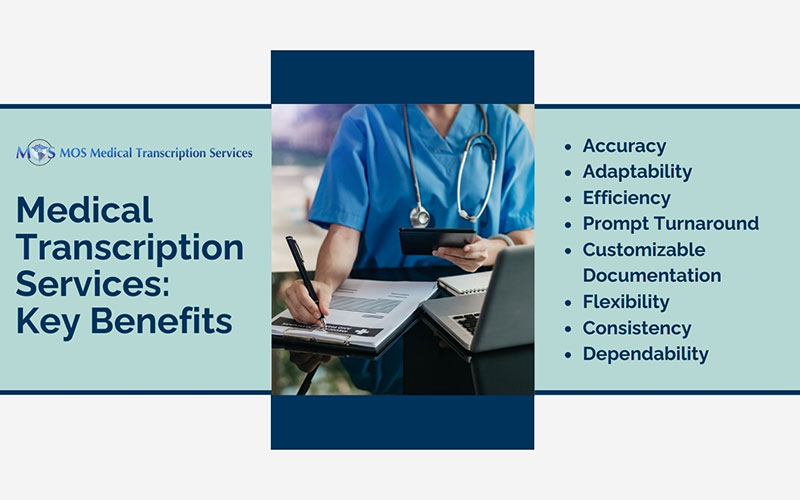Table of Contents
Electronic Health Records (EHRs) have the potential to improve many aspects of care. However, EHR data entry during the patient encounter can be a challenge for physicians, with repercussions on patient care. This has led to the widespread use of medical transcription services to manage EHR documentation. Let’s explore the benefits of dictated medical transcription – a vital component in the seamless documentation of patient encounters.
Physician Challenges in EHR Data Entry
EHRs have the potential to decrease medical errors, improve communication among healthcare providers, and boost care coordination. To leverage these advantages, accurate and efficient EHR data entry is essential. However, most physicians are not adept at data entry. According to a study published in Mayo Clinic Proceedings, physicians spend up to two hours in the EHR for every hour they spend face-to-face with the patient.
“Taking as much as 20 minutes to update a single record, due to time constraints, this task is often done after-hours, significantly increasing the chance of human error and inaccurate data”, says Brent Lauinger, the EVP of business development of Cascade MD (www.ohca.com). Overtime is often necessary to complete the task, a significant problem for an already exhausted workforce.
“Physician burnout as a whole is a multifaceted problem, but people are retiring early or going part-time because they’re spending so much time on the computer, they don’t feel they get enough time to take care of their patients,” said Philip J. Kroth, MD, MS, lead author of a study titled Association of Electronic Health Record Design and Use Factors With Clinician Stress and Burnout (www.ama-assn.org).
One solution is to use scribes in the examination room. However, the presence of a third party may distract or make patients uncomfortable, potentially impacting the doctor-patient relationship. Other possible disadvantages of using scribes include ensuring patient confidentiality and compliance with privacy regulations, costs of training and onboarding scribes and their high turnover rates, which can impact workflow.
Today, dictated medical transcription using advanced technology has emerged as a vital component in the seamless documentation of patient encounters.
How Medical Dictation and Automated Transcription Work
Dictated medical transcription offers enhanced communication, accuracy, and efficiency in creating comprehensive patient records. In this automated process, healthcare professionals dictate their observations, diagnoses, and treatment plans into a handheld digital recorder, computer, or mobile app with speech recognition. The device transcribes the dictation into written records, eliminating the need for manual typing.
Voice-enabled documentation operates through a combination of speech recognition, natural language processing, and machine learning technologies. Advanced speech recognition technology is trained to understand and interpret spoken language and convert it into text. It often uses NLP algorithms that understand the context and meaning of the spoken words. The technology can analyze speech patterns, accents, and intonations. It can also interpret the user’s intentions, resulting in more contextually relevant text.
The key benefits of dictated medical transcription include:
- As the physician engages directly with the patient, speech recognition technology captures the verbally articulated observations, medical history, symptoms, and treatment plans in real-time.
- The spoken words are converted into accurate and comprehensive text directly within the patient’s electronic record.
- This real-time transcription process allows physicians to seamlessly integrate documentation into their workflow, reducing the time spent on post-consultation data entry.
- As the system is trained on medical lexicons and terminology, it can ensure accurate transcriptions of complex medical terms, medications, and procedures.
- The system adapts to the user’s unique speech patterns and preferences, it allows physicians to maintain their individualized documentation styles.
- Cloud-based solutions and mobile applications enhance flexibility and accessibility by enabling physicians to access and update patient records securely from various locations.
- With its machine learning capabilities, speech recognition technology continuously learns and adapts, improving accuracy over time based on user interactions and feedback.
By seamlessly integrating spoken words into the EHR system, this technology has become the ‘voice of healthcare’. It ensures that relevant and comprehensive patient information is accurately captured in real time, enhancing the overall quality of healthcare documentation. Automated medical dictation saves time for physicians and transcriptionists as it transcribes what the physician says quickly without the need for human intervention.
Role of Medical Transcription Services
Even with these advancements, most physicians continue to partner with a professional medical transcription service company to ensure quality medical documentation of patient encounters. By providing human expertise, contextual understanding, and quality assurance, medical transcription services complement the advancements in voice-enabled documentation technologies. Human transcriptionists review and edit transcriptions to ensure accuracy, correct any misinterpretations, and address nuances that automated systems might miss.
To learn more about this, read: Study: Medical Transcriptionist Review improves accuracy of Speech Recognition Generated Clinical Documents
With their proficiency in medical terminology, medical transcriptionists can ensure error-free documentation. They can also ensure consistency in formatting and style across various medical records, complying with industry and organizational documentation standards. Medical transcription services also adhere to HIPAA regulations, maintaining the confidentiality and security of patient data.
Reliable companies can provide scalable, timely, and customizable documentation to meet every practice’s unique needs.
By complementing voice-enabled documentation technologies, human transcriptionists ensure that healthcare professionals have access to accurate, secure, and compliant medical records, contributing to the overall quality of patient care and documentation.




